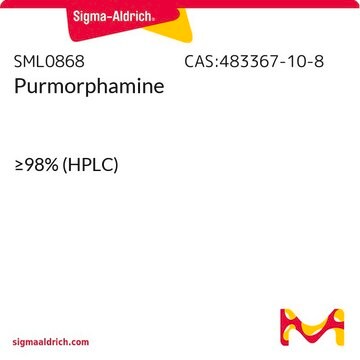528117
PI 3-K inhibitor IX, PIK-90
The PI 3-K inhibitor IX, PIK-90, also referenced under CAS 677338-12-4, controls the biological activity of PI 3-K. This small molecule/inhibitor is primarily used for Phosphorylation & Dephosphorylation applications.
Synonym(s):
PI 3-K inhibitor IX, PIK-90, N-(2,3-Dihydro-7,8-dimethoxyimidazo[1,2-c]quinazolin-5-yl)-3-pyridinecarboxamide, mTOR Inhibitor VI
Sign Into View Organizational & Contract Pricing
All Photos(1)
About This Item
Empirical Formula (Hill Notation):
C18H17N5O3
CAS Number:
Molecular Weight:
351.36
UNSPSC Code:
12352200
NACRES:
NA.77
Recommended Products
Quality Level
Assay
≥98% (HPLC)
form
solid
manufacturer/tradename
Calbiochem®
storage condition
OK to freeze
protect from light
color
pale yellow
solubility
DMSO: 0.5 mg/mL
shipped in
wet ice
storage temp.
−20°C
General description
A cell-permeable imidazoquinazoline compound that acts as a potent, reversible, and ATP-competitive inhibitor against all three classes of PI 3-K kinases (IC50 = 11, 18, 47, 58, 64, 350, and 830 nM against p110α, p110γ, PI 3-KC2α, p110δ, PI 3-KC2β, p110β, and hsVPS34, respectively), as well as several PIKKs (IC50 = 13, 610, and 1050 nM against DNA-PK, ATM, and mTORC1, respectively) and PI 4-KIIIα (IC50 = 830 nM), while exhibiting much reduced potency against PI 4-KIIIβ and ATR (IC50 = 3.1 and 15 µM, respectively) and little or no activity toward PI 4-KIIα, PIPKs (IC50 >100 µM), and a panel of 36 commonly studied protein kinases (<15% inhibition at 10 µM). Effectively suppreses insulin-stimulated phosphorylations of Akt and rpS6 in 3T3-L1 adipocytes and L6 myotubes in a dose-dependent manner in vitro (by >90% at 2.5 µM) and completely prevents insulin-induced blood glucose decline in mice in vivo (10 mg/ml, i.p.).
Packaging
Packaged under inert gas
Warning
Toxicity: Standard Handling (A)
Preparation Note
Slight warming may be required to for complete solubility.
Reconstitution
Following reconstitution, aliquot and freeze (-20°C). Stock solutions are stable for up to 3 months at -20°C.
Other Notes
Fan, Q.W., et al. 2007. Cancer Res.67, 7960.
Fan, Q.W., et al. 2006. Cancer Cell9, 341.
Knight, Z.A., et al. 2006. Cell125, 733.
Fan, Q.W., et al. 2006. Cancer Cell9, 341.
Knight, Z.A., et al. 2006. Cell125, 733.
Legal Information
CALBIOCHEM is a registered trademark of Merck KGaA, Darmstadt, Germany
Storage Class Code
11 - Combustible Solids
WGK
WGK 3
Flash Point(F)
Not applicable
Flash Point(C)
Not applicable
Certificates of Analysis (COA)
Search for Certificates of Analysis (COA) by entering the products Lot/Batch Number. Lot and Batch Numbers can be found on a product’s label following the words ‘Lot’ or ‘Batch’.
Already Own This Product?
Find documentation for the products that you have recently purchased in the Document Library.
Lay Teng Ang et al.
Cell, 185(14), 2523-2541 (2022-06-24)
Stem cell research endeavors to generate specific subtypes of classically defined "cell types." Here, we generate >90% pure human artery or vein endothelial cells from pluripotent stem cells within 3-4 days. We specified artery cells by inhibiting vein-specifying signals and vice
Keishi Kishimoto et al.
Nature protocols, 17(11), 2699-2719 (2022-08-18)
Development of visceral organs such as the esophagus, lung, liver and stomach are coordinated by reciprocal signaling interactions between the endoderm and adjacent mesoderm cells in the fetal foregut. Although the recent successes in recapitulating developmental signaling in vitro has
Tomoka Takao et al.
STAR protocols, 3(4), 101786-101786 (2022-11-02)
Here, we present a protocol for the selective differentiation of human pluripotent stem cells mimicking human developmental processes into expandable PRRX1+ limb-bud mesenchymal (ExpLBM) cells. This approach enables expansion through serial passage while maintaining capacity for chondrogenic differentiation. For complete
Stephen J Gadomski et al.
iScience, 27(8), 110537-110537 (2024-08-28)
Stem cell therapies for degenerative cartilage disease are limited by an incomplete understanding of hyaline cartilage formation and maintenance. Human bone marrow stromal cells/skeletal stem cells (hBMSCs/SSCs) produce stable hyaline cartilage when attached to hyaluronic acid-coated fibrin microbeads (HyA-FMBs), yet
Alexandra K Eicher et al.
Cell stem cell, 29(1), 36-51 (2021-12-03)
Human organoid model systems lack important cell types that, in the embryo, are incorporated into organ tissues during development. We developed an organoid assembly approach starting with cells from the three primary germ layers-enteric neuroglial, mesenchymal, and epithelial precursors-that were
Our team of scientists has experience in all areas of research including Life Science, Material Science, Chemical Synthesis, Chromatography, Analytical and many others.
Contact Technical Service








